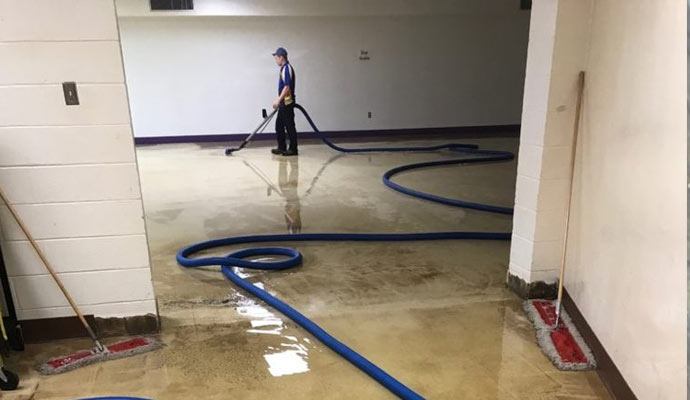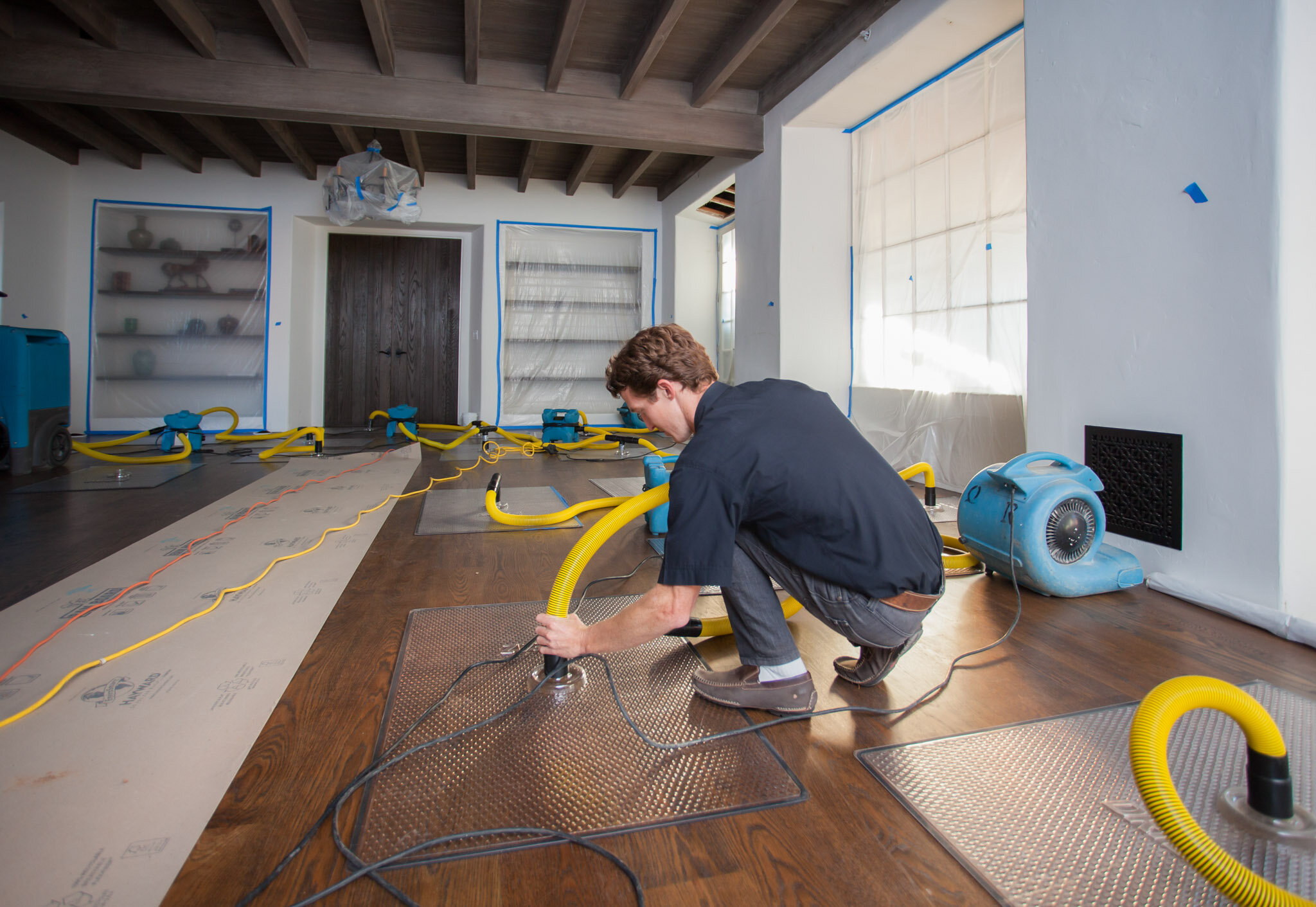Water Damage Restoration 101: Recognizing the Process and Price
Water damage can strike suddenly, leaving property owners in a state of complication. Comprehending the reconstruction procedure is vital for effective healing. From assessing the damage to picking the best company, each step impacts the overall result and cost. Elements such as the sort of water damage and urgency additionally play a considerable duty. What are the particular strategies used in restoration, and how can one plan for prospective costs?
Sorts Of Water Damage

Preliminary Evaluation and Examination

Water Removal Strategies
Following the preliminary evaluation, effective water removal techniques are used to alleviate damage and stop further issues. These methods entail the use of specialized equipment such as completely submersible pumps and industrial-grade vacuums - Water Damage Restoration. The option of method depends upon the quantity of water existing and the type of materials influenced. For standing water, submersible pumps are commonly utilized for fast elimination, while vacuums are optimal for extracting water from carpets and furniture. In addition, advanced methods like water extraction mats might be utilized for hard-to-reach locations - Flood Cleanup Services. The goal is to get rid of as much water as possible, minimizing the possibility for mold development and architectural damage. Trigger and efficient water removal is crucial in the general water damage repair procedure
Drying and Dehumidification Process
When the water extraction is total, the drying out and dehumidification process comes to be critical to bring back the affected area. This stage normally utilizes industrial-grade dehumidifiers and air moving companies to efficiently lower moisture levels. The dehumidifiers attract in wet air, removing excess moisture, while air moving companies circulate air to accelerate evaporation. Monitoring tools is frequently used to track moisture and temperature levels, making certain optimal drying out problems. The duration of this process can vary depending upon the level of the water damage and environmental elements. It is necessary to thoroughly dry all influenced products, including walls, floor covering, and home furnishings, to stop mold growth and structural damage. Appropriate implementation of this action is essential for an effective restoration outcome.
Cleaning Up and Sterilizing Afflicted Locations
As soon as the drying out procedure is full, an extensive preliminary evaluation and assessment of affected locations is vital to identify contamination degrees. Efficient cleansing methods and proper products must after that be employed to get rid of particles and spots. Sanitization and disinfection methods are crucial to guarantee that dangerous pathogens are gotten rid of, bring back the area to a risk-free problem.
Preliminary Evaluation and Inspection
Prior to beginning any type of repair initiatives, a detailed initial evaluation and assessment of the influenced locations are crucial for effective cleansing and sanitizing. This procedure involves recognizing the level of water damage, figuring out the source of the water breach, and evaluating the materials impacted. Inspectors usually try to find signs of mold and mildew development, architectural integrity problems, and harmed personal belongings. The analysis additionally consists of examining moisture levels using specialized tools to guarantee no surprise water pockets remain, as these can bring about further issues. Documenting the findings is essential for intending the following action in the remediation process. An in-depth first evaluation makes it possible for remediation experts to design a targeted approach for efficient cleaning and sanitizing, eventually decreasing damage and health and wellness dangers.
Cleansing Strategies and Products
Effective cleaning and sterilizing of water-damaged locations require a range of methods and items customized to the particular materials impacted. For porous surface areas like drywall and carpeting, removal approaches are important to get rid of excess moisture, adhered to by deep cleaning with specialized detergents. Non-porous products such as tile or steel can be cleansed utilizing commercial-grade cleansers that properly get rid of impurities. Vapor cleansing is one more effective strategy, especially for rugs and upholstery, as it uses heats to remove microorganisms and mold and mildew (Flood Cleanup Services). In addition, eco-friendly items are significantly prominent for their security and effectiveness - Water Damage Restoration. Inevitably, selecting the suitable cleansing techniques and products not only assures instant cleanliness yet likewise aids in preventing additional damage and carcinogen related to water invasion
Sanitization and Disinfection Methods
When addressing water damage, appropriate sanitization and disinfection approaches are necessary to guarantee the security and health of the damaged atmosphere. After first cleaning, surface areas should be treated with ideal disinfectants to remove microorganisms, mold and mildew, and germs that flourish in moist problems. Common techniques include making use of EPA-approved chemical anti-bacterials, which can be applied with splashing or wiping methods. Furthermore, ultraviolet (UV) light systems can effectively sterilize locations by counteracting microorganisms without severe chemicals. The choice of technique often depends on the type of materials impacted and the degree of contamination. Eventually, complete sanitization not only brings back a secure space yet additionally helps prevent future health and wellness threats associated with remaining a fantastic read wetness and mold growth.

Fixings and Restoration Options
Assessing the damage created by water direct exposure is vital for figuring out the ideal repair services and repair alternatives. Homeowners may deal with various problems, including harmed drywall, deformed flooring, and jeopardized structural aspects. Depending on the degree of the damage, repair services might entail changing areas of drywall, mounting brand-new flooring, or reinforcing structural light beams. In instances of serious damage, complete substitute of damaged materials may be required. Additionally, professional conservators typically recommend using wetness meters to analyze surprise wetness degrees prior to selecting the most effective strategy. It is essential to act quickly to stop mold development and more degeneration. Selecting the ideal options not only recovers the residential property however likewise ensures long-term safety and capability.
Aspects Influencing Restoration Costs

The level of water damage directly influences the remediation sets you back property owners can anticipate to incur. Aspects such as the source of the water, the duration of direct exposure, and the damaged products greatly influence prices. For circumstances, clean water damage from a damaged pipeline is generally less pricey to restore compared to damage triggered by sewer. In addition, the level of contamination dictates the requirement for specialized cleansing and disposal solutions, further raising expenses. Geographic location also contributes, as regional labor rates and availability of remediation services can differ. The necessity of the feedback influences prices; quicker treatments typically lead to decrease total expenditures by protecting against more damage. Understanding these factors is vital for homeowners when estimating repair prices.
The three primary types of water damage are classified based on contamination degrees: clean water, grey water, and black water. A thorough initial analysis and inspection are crucial actions in the water damage reconstruction procedure. For standing water, completely submersible pumps are usually used for rapid elimination, while vacuum cleaners are ideal for extracting water from carpetings and furniture. The degree of water damage directly influences the remediation sets you back property owners can expect to sustain. Clean water damage from a busted pipe is usually less expensive to restore compared to damage caused by sewage.